Now
here's a funny thing, you start out with quite a straight forward
enquiry and things quickly turn into something rather less simple, take
for example this portrait of Sir Anthony Cope. The image is reproduced, rather poorly it must be said, in William Pott's History of Banbury (Potts 1978: 119),
I have the second edition but I assume it was included in the first
edition of 1958. Jeremy Gibson also uses it in his piece for the Cake and
Cockhorse 'Heraldry, Horology and Horticulture at Hanwell' (Gibson 1988: 16).
In both cases it is captioned the same way, 'Sir Anthony Cope, Bt. of
Hanwell, M.P. for Banbury from a portrait at Knole Park, Sevenoaks.'
Although it is not very clear here the painting bears the inscription
towards the bottom left hand corner 'Anthony Cope of Hanwell'. We will
address the question of which Sir Anthony this is a little later.
Here is the image scanned from my copy of Potts, not brilliant but bear with me:
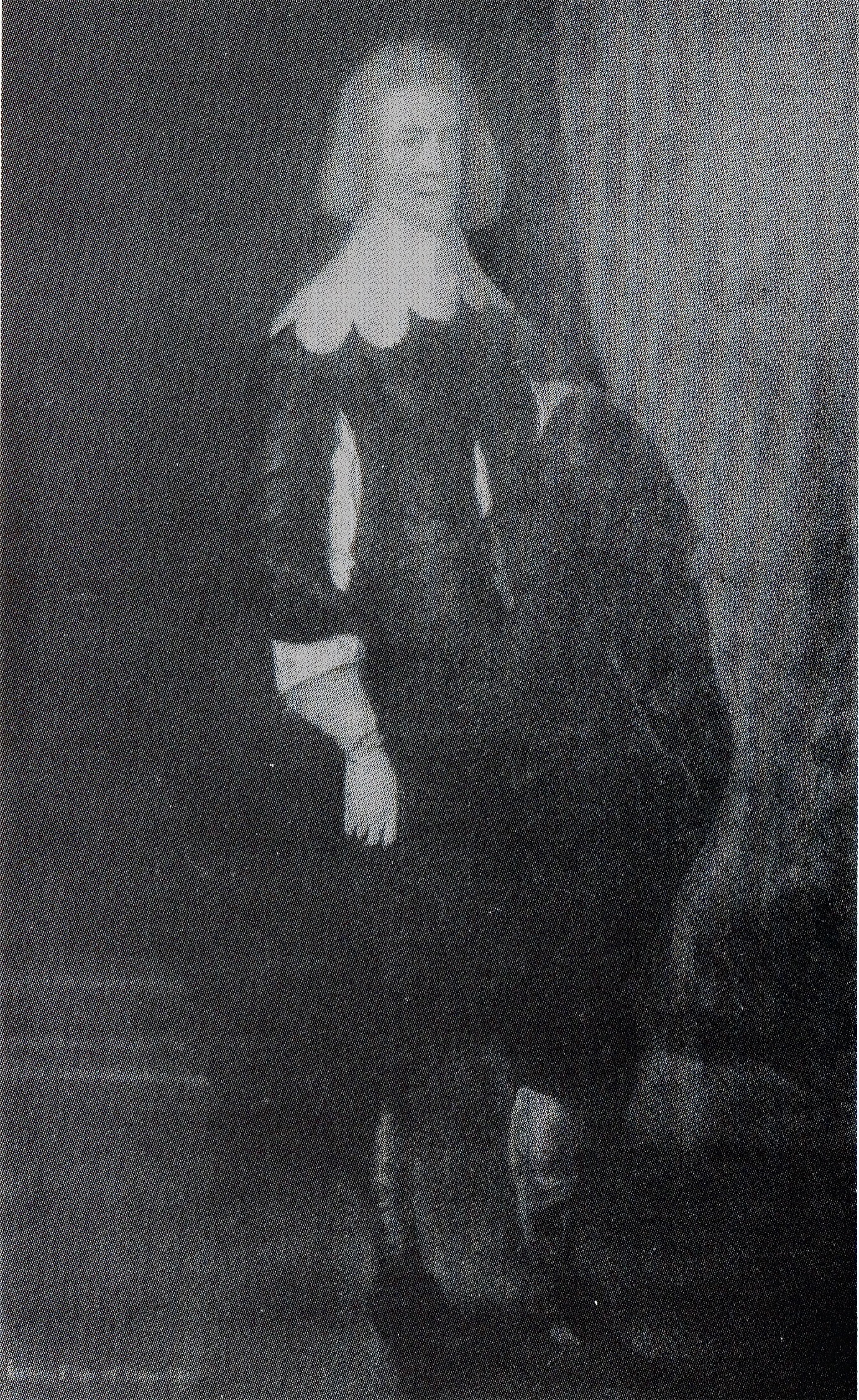
I was quite excited by this and given that Knole is now in the care of the National Trust I was keen to make use of their excellent on-line catalogue to take a look at a better image in colour so I searched for 'Knole' and 'seventeenth century' and 'paintings' and there it was... except it wasn't! I'll probably get into trouble for this but here is their image:
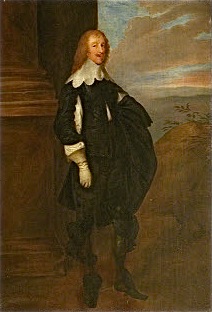
Now although the two are very similar there are some significant differences which again we will return to later. Here is the catalogue entry from Knole:
So what are we to make of this? Could Van Dyck have painted a picture of Sir Anthony, now in the Cobhan Collection? Van Dyck settled in England in 1632 eighteen years after the death of Sir Anthony, the first Baronet, and he died in 1641 when Sir Anthony, the fourth baronet,was just nine years old. It looks as if a sitting really wasn't on the cards for either Anthony.
Back to the picture seen by Potts in 1958 and photographed and sent to Rowena and Christopher when they were making enquiries re publishing a guidebook. It isn't the one catalogued by the Trust, where is it? Indeed more to the point what is it? If we make a detailed comparison it seems clear to me that the inscribed portrait is a copy and, dare I say it, not a particularly good one, of the Van Dyck. Here they are side by side and reduced to monochrome to make comparison easier:

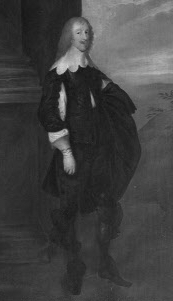
Sir Anthony of Hanwell An Unknown Gentlemen
In both cases we have a soberly dressed gentlemen, standing and slightly turned to his left with his cloak over his right arm and architecture behind his right shoulder. The main difference, apart from the curtain to Sir Anthony's right and the open landscape in the case of the unknown gentleman, lies to my eye in the rather ungainly posture of the first figure. The shoulder is dropped, the neck perhaps a shade too long and the arm hangs straight and rather limply. The slightly awkward stance of Sir Anthony speaks to me of it being a copy of the altogether more natural pose in what is in itself a copy, albeit a better one, of a Van Dyck original. The other feature worth pointing out is Sir Anthony's hair cut, full enough but a little more severe that the flowing locks of the figure of the unknown gentleman.
I did wonder whether there was any way in which the similarity was accidental, was this a standard body of the period onto which the patron's features could be grafted at a reduced price, like Roman statuary? Well thanks to the magic of Google Images I was able in fairly short order to scan through five or six hundred contemporary portraits. The pose and composition was not a particularly common one. I was able to find only a handful of instances of standing figures flanked by columns and curtains or landscapes and here they are:

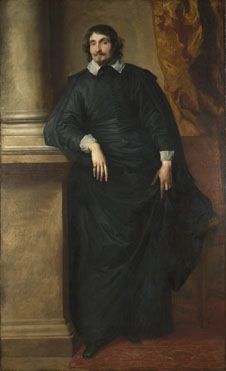
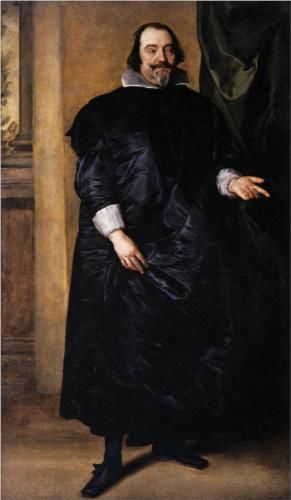
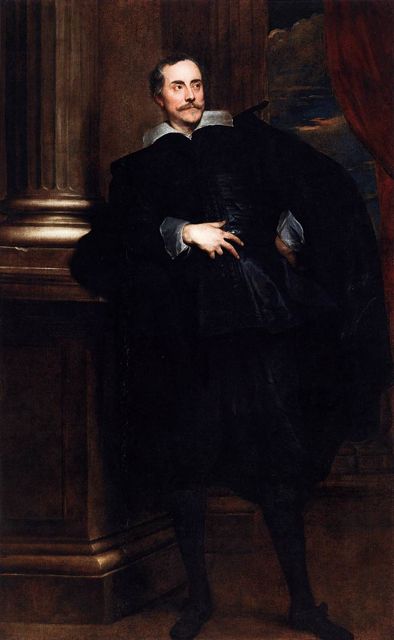
Well, what is the current state of play? Who is portrayed here? Neither Potts or Gibson are clear on the point. In Potts the picture is facing the page which discusses the first baronet's role in the imprisonment of recusants, whilst Gibson's piece is largely about the funeral arrangements for the fourth baronet so not much help there. An added level of complication is added by the information recorded in the Knole House picture guide. The portrait hangs in the Great Hall and is described thus:
Thanks the House and collections Manager Helen Fawbert for this. Clearly someone has spotted the Van Dyck date problem. It could be William I suppose but how has it then come to be mis-labelled?
Here is my best guess at the moment. Some time between 1632 and 1641, and possibly earlier rather than later, Van Dyck painted an unknown gentleman, except of course he wasn't unknown at the time. At some point later, and it could have been much later, the need arose for a portrait of Sir Anthony Cope. Somehow the Van Dyck or the Van Dyck copy came to hand and a further copy made to portray Sir Anthony. If this was to be the first baronet, the puritan, he would need a haircut, so there you have it. Several puzzles remain. Why did the copy and a possible copy of a copy end up at Knole? The fact that the Unknown Gentleman is 'on loan from the Sackville Estate' must be significant as the Sackvilles descended from the Bruern branch of the Copes. Why does the inscribed version not appear in the Trust's catalogue, has it been taken somewhere else?
Of course this is all what Holmes would have described as 'theorising in the absence of facts' so we have potentially at least three similar paintings to track down and examine before we can even approach certainty. Sounds exciting.
y
Here is the image scanned from my copy of Potts, not brilliant but bear with me:

I was quite excited by this and given that Knole is now in the care of the National Trust I was keen to make use of their excellent on-line catalogue to take a look at a better image in colour so I searched for 'Knole' and 'seventeenth century' and 'paintings' and there it was... except it wasn't! I'll probably get into trouble for this but here is their image:

Now although the two are very similar there are some significant differences which again we will return to later. Here is the catalogue entry from Knole:
National Trust Inventory Number 129834
Oil painting on panel, An Unknown Man after Sir Anthony Van Dyck (Antwerp 1599 - London 1641), late 17th century. A full-length portrait, turned to the right, gazing at the
spectator, long, natural, light-brown hair, wearing black with a lace collar. Pillar and building to the left, distant horizon with cloudy sky to the right. The original is in Viscount Cobham's collection.
Provenance
On loan from the Trustees of the Sackville Estate
Makers and roles
after Sir Anthony Van Dyck (Antwerp 1599 - London 1641), artist
Oil painting on panel, An Unknown Man after Sir Anthony Van Dyck (Antwerp 1599 - London 1641), late 17th century. A full-length portrait, turned to the right, gazing at the
spectator, long, natural, light-brown hair, wearing black with a lace collar. Pillar and building to the left, distant horizon with cloudy sky to the right. The original is in Viscount Cobham's collection.
Provenance
On loan from the Trustees of the Sackville Estate
Makers and roles
after Sir Anthony Van Dyck (Antwerp 1599 - London 1641), artist
So what are we to make of this? Could Van Dyck have painted a picture of Sir Anthony, now in the Cobhan Collection? Van Dyck settled in England in 1632 eighteen years after the death of Sir Anthony, the first Baronet, and he died in 1641 when Sir Anthony, the fourth baronet,was just nine years old. It looks as if a sitting really wasn't on the cards for either Anthony.
Back to the picture seen by Potts in 1958 and photographed and sent to Rowena and Christopher when they were making enquiries re publishing a guidebook. It isn't the one catalogued by the Trust, where is it? Indeed more to the point what is it? If we make a detailed comparison it seems clear to me that the inscribed portrait is a copy and, dare I say it, not a particularly good one, of the Van Dyck. Here they are side by side and reduced to monochrome to make comparison easier:


Sir Anthony of Hanwell An Unknown Gentlemen
In both cases we have a soberly dressed gentlemen, standing and slightly turned to his left with his cloak over his right arm and architecture behind his right shoulder. The main difference, apart from the curtain to Sir Anthony's right and the open landscape in the case of the unknown gentleman, lies to my eye in the rather ungainly posture of the first figure. The shoulder is dropped, the neck perhaps a shade too long and the arm hangs straight and rather limply. The slightly awkward stance of Sir Anthony speaks to me of it being a copy of the altogether more natural pose in what is in itself a copy, albeit a better one, of a Van Dyck original. The other feature worth pointing out is Sir Anthony's hair cut, full enough but a little more severe that the flowing locks of the figure of the unknown gentleman.
I did wonder whether there was any way in which the similarity was accidental, was this a standard body of the period onto which the patron's features could be grafted at a reduced price, like Roman statuary? Well thanks to the magic of Google Images I was able in fairly short order to scan through five or six hundred contemporary portraits. The pose and composition was not a particularly common one. I was able to find only a handful of instances of standing figures flanked by columns and curtains or landscapes and here they are:




The Unknown Gentleman from Knole Abbe Scaglia by Van Dyck 1634 Joostde Hertoghe by Van Dyck 1635 Marcello Durazzo by Van Dyck 1641
Well, what is the current state of play? Who is portrayed here? Neither Potts or Gibson are clear on the point. In Potts the picture is facing the page which discusses the first baronet's role in the imprisonment of recusants, whilst Gibson's piece is largely about the funeral arrangements for the fourth baronet so not much help there. An added level of complication is added by the information recorded in the Knole House picture guide. The portrait hangs in the Great Hall and is described thus:
After Sir Anthony Van Dyck (1599–1641)
Called Sir Anthony Cope, 1st Bt, but probably Sir William Cope, 2nd Bt, MP (1577–1637)
Sir Anthony died in 1614, when Van Dyck was only 15. So more probably his eldest son.
Called Sir Anthony Cope, 1st Bt, but probably Sir William Cope, 2nd Bt, MP (1577–1637)
Sir Anthony died in 1614, when Van Dyck was only 15. So more probably his eldest son.
Thanks the House and collections Manager Helen Fawbert for this. Clearly someone has spotted the Van Dyck date problem. It could be William I suppose but how has it then come to be mis-labelled?
Here is my best guess at the moment. Some time between 1632 and 1641, and possibly earlier rather than later, Van Dyck painted an unknown gentleman, except of course he wasn't unknown at the time. At some point later, and it could have been much later, the need arose for a portrait of Sir Anthony Cope. Somehow the Van Dyck or the Van Dyck copy came to hand and a further copy made to portray Sir Anthony. If this was to be the first baronet, the puritan, he would need a haircut, so there you have it. Several puzzles remain. Why did the copy and a possible copy of a copy end up at Knole? The fact that the Unknown Gentleman is 'on loan from the Sackville Estate' must be significant as the Sackvilles descended from the Bruern branch of the Copes. Why does the inscribed version not appear in the Trust's catalogue, has it been taken somewhere else?
Of course this is all what Holmes would have described as 'theorising in the absence of facts' so we have potentially at least three similar paintings to track down and examine before we can even approach certainty. Sounds exciting.
y